

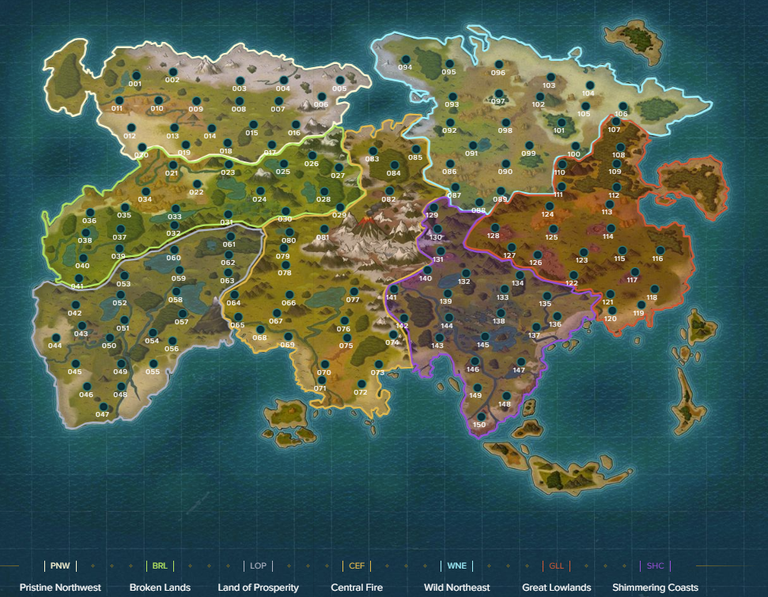
Unlocking the Potential of Praetoria
Land in Splinterlands is one of the game’s features with most future potential, offering players an immersive opportunity to own, cultivate, and build on virtual plots within the continent of Praetoria. This land expansion represents a major opportunity for Splinterlands, as it shifts from purely card-based battles to a multifaceted game that includes land ownership, resource production, and a player-driven economy.
The World of Praetoria
Praetoria, a mystical continent newly unveiled to Splinterlands players, is divided into seven territories, each rich in diverse resources and mysterious secrets waiting to be uncovered. With over 150,000 unique land plots spread across 150 regions, each plot is a non-fungible token (NFT) that allows players to claim a small part of Praetoria. These plots aren’t just virtual spaces—they’re part of a larger game economy where owners can stake resources, produce valuable materials, and ultimately craft new items and spells. As players explore and develop their plots, they will contribute to an interconnected economy, trade resources, and work together (or compete) to unlock Praetoria’s hidden secrets.
Current Land Phases: Phase 1.5 and Phase 2
The Splinterlands land expansion is designed to roll out in multiple phases, gradually adding depth and complexity to gameplay. Currently, we are in Phase 1.5, which allows players to stake cards and DEC on their land plots, beginning initial resource production. This phase introduced foundational mechanics, giving players a chance to start exploring their land, assign worker cards, and generate Production Points (PP) by staking Dark Energy Crystals (DEC). This early production helps players prepare for the next phases by generating essential resources.
In Phase 2, anticipated in 2026, landowners will gain access to full-scale buildings, resource refinement, and a more extensive economy. Phase 2 is expected to offer over 30 building options and 50 resource types that landowners can manage, refine, and trade. Players will also have the ability to craft unique items and spells, adding a new layer of strategy to Splinterlands’ gameplay. This phase will be critical for players aiming to produce refined resources and prepare for the game’s future, as these crafted items will eventually impact battles and other in-game dynamics.
Preparing for the Next Steps
As land phases continue to roll out, players can take steps now to optimize their plots for future expansions:
- Surveying land plots to unlock specific terrain types and rare features, like magical or occupied land, which offer distinct advantages.
- Staking worker cards on their land to start resource production early, particularly focusing on older, higher-BCX cards for enhanced productivity.
- Accumulating DEC and resource packs to fuel future production and participate fully in Phase 2’s building mechanics and resource refinement.
In this evolving landscape, land in Splinterlands offers players more than passive ownership; it’s a pathway to unlock unique resources, participate in a player-driven economy, and ultimately shape the future of the Splinterlands world.

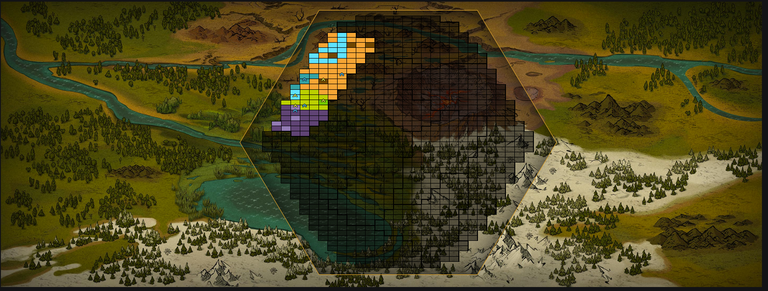
The Basics: Understanding Land Deeds, Regions, and Terrain Types
In Splinterlands, land ownership is a central feature that enables players to claim, survey, and develop plots within the newly accessible continent of Praetoria. Understanding the structure of land ownership and how land is organized within Praetoria helps players strategically manage their resources and maximize productivity. This section provides an overview of land deeds, how plots are organized, and the influence of terrain types and elemental affinities on gameplay.
Land Deeds: Ownership and the Process of Claiming and Surveying
Land deeds are digital NFTs that signify ownership of a specific plot within Praetoria. These deeds can be bought, sold, and traded on the blockchain and represent a tangible piece of the Splinterlands universe. When players hold a land deed, they have a claim on a unique plot in one of Praetoria’s seven territories. Initially, deeds are in an unsurveyed state, meaning only the basic location (such as region and tract) is known.
To unlock the full potential of their land, players must survey their deeds. Surveying reveals critical attributes of each plot, such as:
- Terrain Type (e.g., Forest, Mountain, Desert),
- Rarity (Common, Rare, Epic, Legendary),
- Resource Type (Natural, Magical, or Occupied).
Surveying allows players to see what types of resources they can produce on their land, and it activates additional features like rarities and elemental bonuses.
Regions, Tracts, and Plots: Structure and Strategic Placement
The land in Praetoria is divided into a layered structure, with 150,000 individual plots organized across:
- 150 Regions, each containing 1,000 plots,
- 10 Tracts per region, with 100 plots per tract,
- Individual Plots within each tract.
Each region within Praetoria has unique characteristics and a dominant terrain type, with secondary terrains interspersed, adding strategic depth. Land plots within a single region are contiguous, meaning players who own multiple plots within the same tract or region can more effectively manage resources and increase productivity across a cohesive area.
For example, owning plots in the same region enables more efficient staking of DEC, as DEC staking requirements are calculated on a region-wide basis for each owner. This allows players to streamline resource allocation, especially when managing larger numbers of plots.
Terrain Types and Elemental Affinities
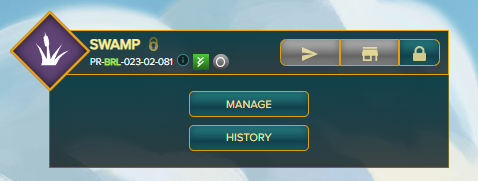
There are 14 distinct terrain types in Praetoria, each conferring specific advantages and disadvantages based on the elemental affinities of the worker cards assigned to them. These terrain types determine which resources are accessible on a plot and influence the productivity of cards with matching or opposing elemental affinities:
- Badlands (+10% Fire, -50% Life, +10% Death)
- Bog (-50% Fire, +10% Water, -50% Life, +10% Death)
- Caldera (+10% Fire, -50% Death, -50% Earth, +10% Dragon)
- Canyon (+5% Fire, -10% Water, -10% Life, +5% Death, -10% Earth, +5% Dragon)
- Desert (+10% Fire, -50% Water, -50% Life, +10% Dragon)
- Forest (+10% Life, -50% Death, +10% Earth, -50% Dragon)
- Hills (-50% Water, +10% Life, -50% Death, +10% Dragon)
- Jungle (+10% Life, -50% Death, +10% Earth, -50% Dragon)
- Lake (-50% Fire, +10% Water, +10% Earth, -50% Dragon)
- Mountain (+10% Fire, -50% Water, +10% Death, -50% Dragon)
- Plains (-50% Water, +10% Life, -50% Earth, +10% Dragon)
- River (-50% Fire, +10% Water, +10% Earth, -50% Death)
- Swamp (-50% Fire, +10% Water, -50% Life, +10% Death)
- Tundra (-10% Fire, +5% Water, +5% Life, -10% Death, +5% Earth, -10% Dragon)
These terrain-based bonuses encourage players to strategically assign cards that align with the plot’s terrain type for enhanced production. For example, using Fire-element cards on a Desert plot yields a +10% boost in Production Points, whereas assigning Water-element cards to the same plot incurs a -50% penalty.
Understanding these nuances allows players to assign cards that maximize productivity, making terrain type an essential factor in managing and optimizing land resources.

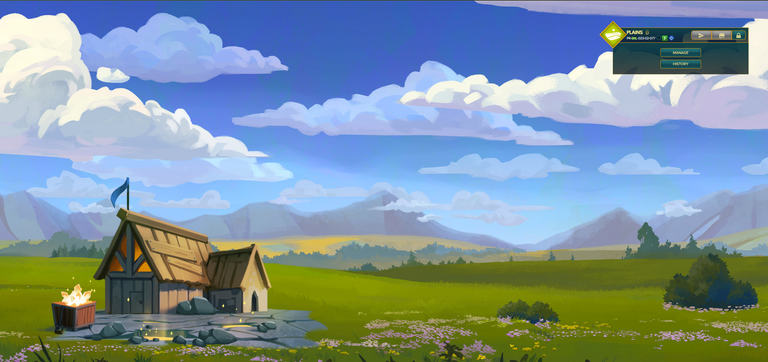
Surveying and Plot Characteristics: Unlocking the Full Potential of Land
Surveying is a crucial process in the Splinterlands land expansion that allows landowners to uncover the hidden attributes of their land plots. This phase not only reveals the resources that a plot can produce but also provides essential details on the terrain type, rarity, and resource type, all of which influence productivity and strategy. By surveying, landowners gain insights that enable more effective planning and resource management, especially as Splinterlands progresses through the land phases.
Importance of Surveying: Revealing Plot Attributes
When a plot is first claimed, it is in an unsurveyed state, meaning only the basic information such as the region and tract is known. Surveying a plot provides vital information, including:
- Terrain Type: Determines which resources the plot can produce and which elemental affinities gain productivity bonuses or penalties on that land.
- Rarity: Indicates the quality and abundance of resources the plot can yield.
- Resource Type: Defines the specific resources the land produces, whether they are natural, magical, or occupied resources.
The surveying process effectively "activates" the land, allowing players to start staking cards and producing resources based on the attributes revealed.
Rarities: Common, Rare, Epic, Legendary
The rarity of a plot—categorized as Common, Rare, Epic, or Legendary—significantly impacts resource production. Higher rarity plots yield more resources and offer better productivity boosts, which makes them highly valuable assets within Praetoria. Each rarity level has a probability of occurring upon surveying, with rarer plots offering greater production boosts:
- Common (75% probability): Base production with no additional boosts.
- Rare (20% probability): +10% production boost.
- Epic (4% probability): +40% production boost.
- Legendary (1% probability): +100% production boost.
Rarity boosts apply specifically to resource production, making rare, epic, and legendary plots highly desirable for landowners aiming to maximize their resource yield.
Resource Types: Natural, Magical, Occupied
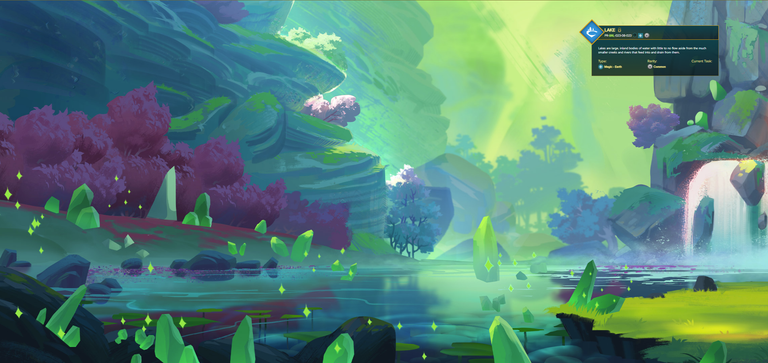
Each surveyed plot is categorized by one of three resource types—Natural, Magical, or Occupied. These types influence the nature of resources that can be produced and often come with unique benefits:
Natural Plots: These are the standard plots, primarily producing foundational resources such as Grain, Wood, Stone, and Ores, based on the terrain type. While they don’t receive special production boosts, natural plots form the backbone of resource production in Praetoria, supplying essential materials for construction and refinement.
Magical Plots (12% probability): Magical plots contain deposits of one of six elemental resources—Virtulium (Life), Ulana Seeds (Earth), Sparkstone (Fire), Bottled Storms (Water), Reclaimed Souls (Death), and Heliostones (Dragon). These resources are rare and highly valuable, as they are necessary for crafting advanced items and spells. Magical plots offer a 100% production boost specifically for research-related activities, allowing players to progress faster in projects tied to the Secret of Praetoria.
Occupied Plots (3% probability): Occupied plots are unique as they are home to mystical or fearsome creatures that must be managed to produce resources. These plots provide another 100% production boost but focus on SPS mining instead of standard resources, offering valuable assets for players interested in staking or liquidity operations in Splinterlands’ economic system. Occupied plots can be challenging to work with but are incredibly lucrative in terms of SPS yield.
High-Value Plots: Magical and Occupied

Magical and Occupied plots are exceptionally valuable in Praetoria due to their unique production boosts and the types of resources they generate. These plots have the potential to provide players with an advantage in resource production, particularly for crafting items and spells or for accumulating SPS through mining. Because of their limited probability upon surveying (12% for Magical and 3% for Occupied), these plots are rare and often sought after by players aiming to maximize their land’s profitability and efficiency.
- Magical Plots: Essential for generating high-value magical resources that will become vital in later phases for crafting powerful in-game items.
- Occupied Plots: Specialize in SPS mining, offering a unique way for players to increase their SPS holdings and contribute to Splinterlands’ token economy.
Surveying to reveal these characteristics allows players to strategically position themselves within Praetoria’s economy, maximizing plot efficiency and preparing for the broader crafting and resource-refinement features expected in the future phases of land development.


Card Staking and Productivity: Maximizing Resource Output
One of the most strategic aspects of Splinterlands land management is staking worker cards on each plot to generate resources. Each staked card contributes Production Points (PP) based on its level, rarity, edition, and even certain land bonuses. Additionally, players can boost production through staked Dark Energy Crystals (DEC), power sources, and special assets like Runi, Totems, and Titles. Understanding how to maximize production on each plot can make a significant difference in the yield from your land.
Worker Cards and Production Points (PP)
Each plot in Praetoria can support up to five worker cards, which contribute a base level of Production Points (PP) per hour. The amount of PP generated depends on multiple factors:
- Card Level: Higher-level cards produce more PP. Cards closer to their maximum BCX (Base Card eXperience) yield the highest PP.
- Rarity and Foil: Higher-rarity cards (Common to Legendary) produce more PP, with Legendary cards producing the most. Gold Foil cards double the production rate of their regular foil counterparts.
- Edition Multipliers: Older editions such as Alpha and Beta provide significant production multipliers, making them particularly valuable for land.
The following table provides the base PP per hour for max-level cards:
- Common: 1,000 PP (Regular), 2,000 PP (Gold Foil)
- Rare: 1,100 PP (Regular), 4,000 PP (Gold Foil)
- Epic: 1,250 PP (Regular), 6,000 PP (Gold Foil)
- Legendary: 1,500 PP (Regular), 10,000 PP (Gold Foil)
Additionally, editions affect productivity:
- Alpha: 10x multiplier
- Beta: 5x multiplier
- Untamed: 2x multiplier
These multipliers and bonuses make older, higher-rarity, and gold foil cards exceptionally powerful for land production.
Importance of Staking DEC and Using Power Sources or Runi
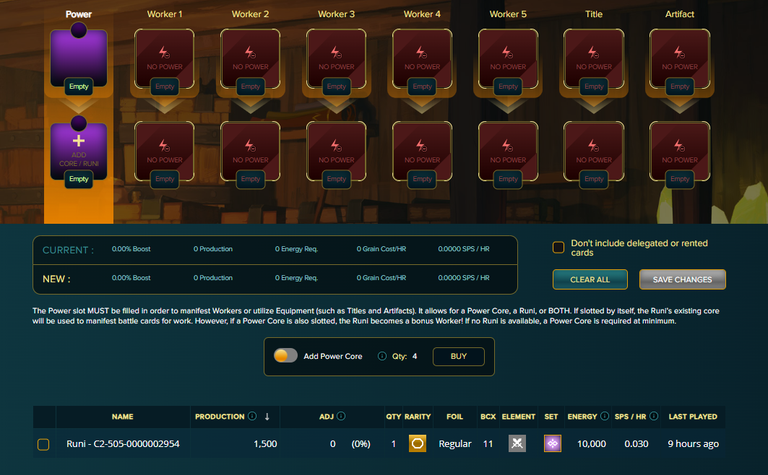
To keep workers active and productive on a plot, players must stake Dark Energy Crystals (DEC) as a type of “fuel.” Each card requires a staked amount of DEC proportional to its BCX, with max-level cards requiring 10,000 DEC each. Lower-level cards require less DEC in proportion to their level, but if insufficient DEC is staked, productivity will decrease across all plots within a region.
In addition to DEC, each plot requires a Power Source to keep the workers operational. Power Sources can be purchased for 5,000 DEC or included with the “Building in a Box” starter package. Alternatively, a Runi card can function as a Power Source, reducing the DEC requirement and allowing up to five cards to work on the plot. If both a Runi and a separate Power Source are used on a plot, players can have a sixth worker card, significantly enhancing production potential.
Enhancing Production: Totems, Titles, Runi, and Other Boosts
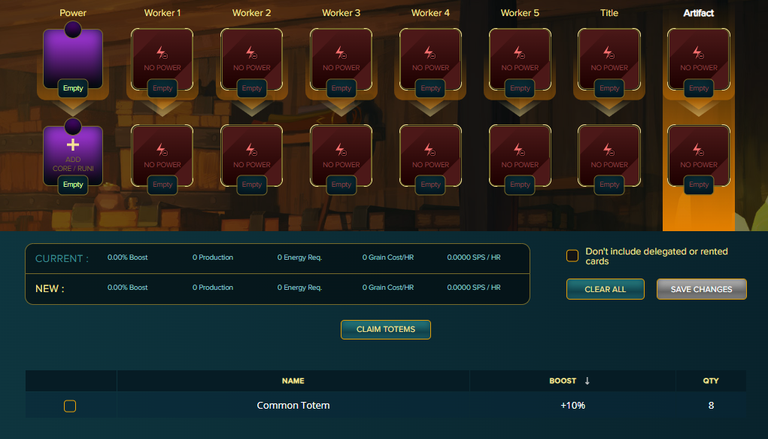
To further amplify productivity, players can apply various boosts:
I. Totems: Totems can be assigned to plots for production boosts. Each rarity of Totem offers a specific increase in PP:
- Common Totem: +10% boost
- Rare Totem: +25% boost
- Epic Totem: +50% boost
- Legendary Totem: +100% boost
II. Titles: In-game Titles provide morale and boost PP when assigned to a plot, with higher rarity Titles offering larger boosts:
- Rare Titles: +10% boost
- Epic Titles: +25% boost
- Legendary Titles: +50% boost
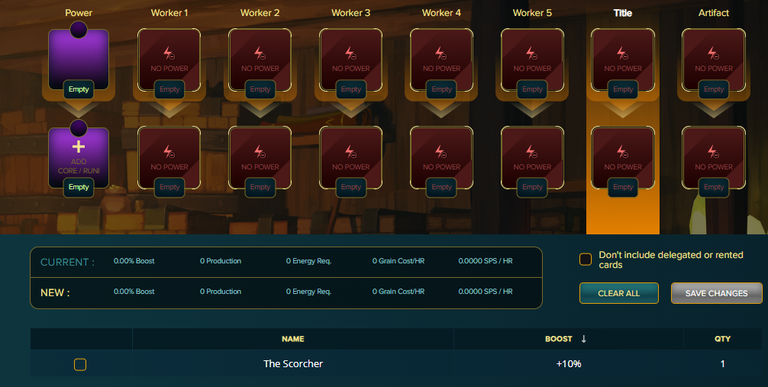
III. Runi: When assigned as a worker on a plot, Runi cards provide a 100% boost to the base PP. Runi also doubles as a Power Source, allowing players to save DEC and optimize the number of workers on a plot.
Strategy Tips for Optimizing Productivity
- Maximize High-BCX Cards: Use max-level or high-BCX cards to ensure high PP output. Consider gold foils and older editions (like Alpha and Beta) to leverage multipliers.
- Stack Boosts: Combining Totems, Titles, and Runi on high-rarity plots can lead to significant PP boosts. For example, an Epic land plot with a Legendary Totem, Legendary Title, and a Runi can generate a powerful cumulative boost.
- Focus DEC Staking by Region: Staking DEC on a regional basis allows for easier management and maximizes productivity across multiple plots in that region.
- Utilize Magical or Occupied Plots Strategically: These plots offer specific boosts for research or SPS mining. Assign powerful cards to these plots to leverage their unique bonuses effectively.
By carefully staking cards, DEC, and utilizing the right boosts, players can maximize their plot’s productivity and resource yield, making their land investment in Praetoria highly rewarding.

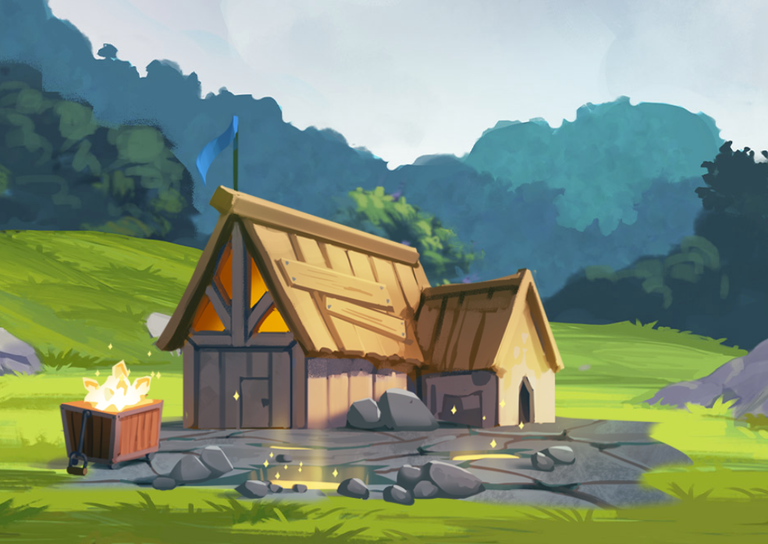
Resource Production and Building Basics: Foundations for Praetoria’s Economy
As land development in Splinterlands progresses, players will gain access to an expansive selection of buildings that drive the Praetorian economy. These buildings enable resource production, refinement, and storage, each contributing uniquely to the broader game economy. Here’s a breakdown of the types of buildings coming in Phase 2, their upgrades, and how they’ll help players prepare for upcoming features like item and spell crafting in Splinterlands battles.
Types of Buildings: Production, Refinement, and Storage
In Phase 2, each land plot can host one building, chosen based on the land’s terrain type and resource availability. Here’s a look at the three main building types and their roles:
I. Resource Production Buildings: These buildings generate the basic resources from natural, magical, or occupied plots. Each building is tied to specific terrain types, ensuring that only plots with the appropriate resources can construct and operate certain buildings.
- Farm: Produces Grain, which is essential for feeding worker cards. Can be built on Plains, River, Bog, and Lake plots.
- Logging Camp: Harvests Wood for construction and fuel, accessible in Swamp, Forest, Tundra, and Jungle plots.
- Quarry: Extracts Stone, a primary resource for building projects, on Desert, Canyon, and Hills plots.
- Mine: Digs for Ores (Iron, Aluminum, Copper, Titanium, Mithril) on Mountain, Badlands, and Caldera plots. Ores are refined into metal bars for advanced construction needs.
- Specialty Magical Buildings: Harvest unique resources like Virtulium, Sparkstone, or Bottled Storms from magical plots and Essences from occupied plots. These resources will be critical for future item and spell crafting.
II. Resource Refinement Buildings: These buildings refine raw materials into more usable forms, such as transforming Grain into specialized Elemental Foods or converting Wood into Lumber.
- Mill: Refines Grain into Elemental Foods, which provide efficiency boosts for workers when matched to their elemental affinities.
- Sawmill: Processes raw Wood into Lumber for building upgrades and maintenance.
- Lithification Site: Infuses Stone with Elemental Essences to produce Elemental Stones, used in construction and other high-level projects.
- Foundry: Smelts Ores into Metal Bars, critical for constructing and maintaining advanced buildings.
- Lapidary: Refines gemstones, like Diamonds and Emeralds, into quality materials for crafting.
- Laboratory: Combines Essences with Elemental Resources to produce Elemental Essences, used in specialized crafting and later for items and spells.
III.Resource Storage Buildings: These buildings provide storage for essential resources, ensuring players have sufficient capacity for their materials. Storage buildings are critical for resource-intensive projects and ongoing production.
- Granary: Stores Grain and other food resources.
- Lumberyard: Stores Wood and processed Lumber.
- Metal Silo: Safely stores various types of Ores and Metal Bars.
- Gem Vault: Stores refined gemstones, critical for crafting high-quality items and spells.
Each storage building is tailored to hold specific resources, and higher-level storage facilities increase overall capacity, enabling players to build stockpiles for future needs.
Building Upgrades and Time Crystals
Each building can be upgraded up to 10 levels, with each level increasing its efficiency, production rate, or storage capacity. Upgrading buildings offers significant benefits:
- Increased Production: Higher-level production buildings yield more resources per unit of time.
- Enhanced Refinement Efficiency: Upgraded refinement buildings consume less raw material for each output unit.
- Expanded Storage Capacity: Higher storage levels accommodate larger quantities of resources, ensuring production can continue uninterrupted.
Upgrading or constructing buildings requires Production Points (PP) generated by worker cards. However, players can accelerate construction by using Time Crystals, which reduce the production requirements by 10,000 PP per Time Crystal. This allows players to fast-track building improvements, particularly helpful for high-priority resources and when preparing for future economic or combat needs.
Future Integration of Items and Spells into Battles
Phase 3 of the land expansion will introduce Items and Spells crafted using resources produced and refined on land plots. These items and spells will impact in-game battles, providing landowners with a valuable new way to engage with the game economy.
- Items: Equip characters or use in battles to gain advantages.
- Spells: Cast during battles for offensive or defensive effects, adding a strategic layer to traditional card combat.
Getting a Head Start on Resource Needs for Future Crafting
Landowners looking to prepare for item and spell crafting can start by focusing on producing and refining specific resources that will be central to crafting. For instance:
- Ores and Metal Bars: Crucial for crafting items that require durability and strength.
- Magical Resources: Essential for producing Elemental Essences, a key component in spell crafting.
- Grain and Elemental Foods: Keep worker cards active and productive, especially when assigned to plots with elemental affinities that boost productivity.
By prioritizing these resources, landowners will be well-positioned to participate in crafting from day one of the Phase 3 release, gaining an advantage in battles and potentially selling crafted items to other players.
The Splinterlands land expansion is designed to empower players with rich resource production options and economic opportunities. Understanding and optimizing each building type will allow players to capitalize on their land and get a head start in crafting powerful items and spells for the game’s future.


Advanced Strategy Tips for Maximizing Land Potential
The key to fully leveraging your land in Splinterlands lies in advanced strategies for optimal card use, resource management, and early production. By carefully planning and executing these strategies, players can maximize resource yield, improve economic outcomes, and prepare for future expansions, including the crafting of items and spells.
I. Optimal Card Use: High Multipliers and Favorable Terrain
Selecting the right cards for each plot is essential for maximizing Production Points (PP) and resource output. Here are strategies to help players assign cards effectively:
- Prioritize Older Edition Cards: Older editions like Alpha and Beta provide significant production multipliers (10x for Alpha, 5x for Beta) compared to newer sets. For plots where maximizing PP is crucial, these cards are invaluable and contribute far more PP than newer editions.
- Utilize Gold Foils: Gold Foil cards double the production rate of regular cards. Given the limited number of slots (up to 5 cards per plot), using Gold Foils boosts productivity considerably. High-BCX Gold Foils are particularly beneficial due to their enhanced production and multiplier effects.
- Match Terrain and Elemental Affinities: Each plot’s terrain type provides production bonuses or penalties to specific elements. For example, Fire cards get a 10% bonus on Desert plots but face a -50% penalty on River plots. Assign cards with matching elemental affinities to plots with favorable terrain to maximize PP output.
- Runi and Legendary Cards: Legendary cards, especially Runi, offer high PP and unique boosts. Runi doubles as a Power Source, enabling an extra worker on the plot and providing a 100% production boost to all other workers. This makes Runi cards strategic additions to high-value plots.
II. Resource Management: Efficient Storage and Refinement
Efficient resource management is essential for both maximizing plot output and preparing for future phases, such as crafting items and spells. Here’s how to prioritize and manage resources effectively:
- Prioritize Storage Upgrades: Storage is vital for uninterrupted production, especially on plots with high output. Upgrade storage buildings like Granaries, Lumberyards, and Metal Silos early to ensure ample space for valuable resources. Without adequate storage, excess resources are lost.
- Focus on High-Value Resources: Magical resources (e.g., Virtulium, Sparkstone) and refined materials (e.g., Elemental Foods, Metal Bars) are valuable for trading and essential for future crafting. Refinement buildings like Sawmills, Foundries, and Mills increase resource quality and make items more desirable for other players, especially when the internal market becomes active.
- Stockpile Essentials: Resources like Grain (for worker sustenance) and refined metals are foundational to nearly all building upgrades and crafting processes. By accumulating these essentials early, players avoid bottlenecks and increase flexibility when demand rises.
- Utilize Time Crystals for Priority Refinement: When you have high-value resources or limited storage, Time Crystals can speed up the production process, ensuring you maximize the output of critical materials. Save these for high-impact moments, especially when preparing resources for crafting items or spells.
III. Preparing for Future Phases: Early Production and Stockpiling
Starting production early on high-value resources allows players to gain a competitive edge when Phase 3 (item and spell crafting) is released. Here’s how early production can pave the way for success:
- Focus on Refinement-Ready Resources: Certain resources like ores, elemental essences, and grains will be pivotal in crafting items and spells. By stockpiling refined forms of these resources (e.g., Metal Bars, Elemental Foods), landowners will be ready for the high demand that will come with new crafting capabilities.
- Allocate Resources for Future Crafting: Magical resources from plots with rare deposits are especially valuable and can be reserved for crafting. These resources will play a critical role in creating advanced in-game assets such as spells, which require element-specific essences.
- SPS and DEC Accumulation: Land operations consume DEC for staking, and some plots provide SPS as a reward. Early accumulation of DEC and SPS will empower players to continue expanding, upgrading, and refining without resource scarcity.
- Prepare for the Secret of Praetoria: The long-term goal in Splinterlands land is to unlock the Secret of Praetoria, an endeavor that will likely require extensive research resources and community collaboration. By generating and refining research-aligned resources now, players can accelerate their contributions and increase their odds of accessing rare rewards.
Advanced strategies for maximizing land in Splinterlands include carefully selecting high-multiplier cards, managing resources effectively, and accumulating essential materials early. By following these strategies, landowners can ensure they’re well-prepared for future expansions and in the best position to leverage their plots in Praetoria’s evolving economy.

Tools and Resources for Landowners: Optimizing Your Splinterlands Land Management
Effective management of land assets in Splinterlands requires the right tools and resources. Here are some essential tools, guides, and links that can help landowners streamline transactions, optimize productivity, and stay connected with the Splinterlands community.
PeakMonsters: A Comprehensive Land Management Tool

PeakMonsters is an invaluable resource for Splinterlands players, offering a user-friendly interface and robust tools for land transactions, rentals, and resource management. Here’s how PeakMonsters can support landowners:
- Efficient Transactions: PeakMonsters allows for faster and more detailed transactions, making it easier to buy, sell, or rent land and other assets. It includes comprehensive bid management, helping players identify value opportunities or execute batch transactions.
- Resource Tracking: The PeakMonsters interface is optimized for tracking and managing resources across multiple plots, which is particularly useful for players with several land assets. You can view and manage your land details, including worker assignments, DEC staking, and productivity, all in one place.
- Bulk Actions: For players managing a large number of plots, PeakMonsters offers bulk rental cancellations, streamlined bid placement, and other time-saving features that enhance productivity and land management.
While PeakMonsters supports many essential land-related functions, players will still need to use the official Splinterlands site for specific tasks such as buying power cores, exchanging totem tokens, and managing grain on a regional level.
Using the Splinterlands Land Interface

The Splinterlands Land Interface offers essential functionality for directly managing and monitoring your land plots within the game. Here’s a quick guide on navigating its primary features:
- Tracking DEC and Grain: DEC is required for staking to power worker cards, while Grain sustains these workers. To monitor DEC staking and Grain levels:
- Go to the land dashboard, where you can view DEC staked per region. Ensure sufficient DEC is staked to keep worker cards productive, as an under-staked region reduces output across all plots.
- Track Grain levels and transfer Grain as needed from your inventory to land regions. Keep enough Grain on hand to ensure worker productivity, especially when preparing for high-output periods.
- Assigning Workers: Assigning worker cards is key to maximizing production on each plot.
- In the interface, select each plot and assign up to five worker cards based on plot terrain and card elemental affinity for maximum Production Points (PP).
- Use the interface to view each card’s PP contribution and ensure workers are aligned with terrain bonuses for optimal productivity.
- Monitoring Productivity: The land interface provides a comprehensive view of each plot’s productivity, including base production, boosts from totems or titles, and current worker activity. Regularly check this view to optimize assignments or make adjustments as necessary to maintain productivity.
Staying Connected: Splinterlands Support and Community Channels
To stay up-to-date with the latest game updates, troubleshoot issues, and engage with the Splinterlands community, utilize the following official resources:
- Splinterlands Support: For bug reporting, account issues, and technical assistance, players can reach out via the official support portal at Splinterlands Support.
- Community and Discord: Join the Splinterlands Discord server to engage with the community, participate in events, and get real-time support from moderators and experienced players. The Discord server also shares important announcements regarding game updates, land mechanics, and development timelines.
- Splinterlands Hive Blog: Follow the Splinterlands Blog on Hive for updates directly from the development team. This blog posts whitepapers, future plans, and gameplay enhancements, including land phases and upcoming mechanics for crafting items and spells.
By leveraging PeakMonsters for efficient land management, using the Splinterlands interface for hands-on plot management, and staying connected through support and community channels, landowners can maximize their productivity and remain prepared for all updates and expansions in the game.

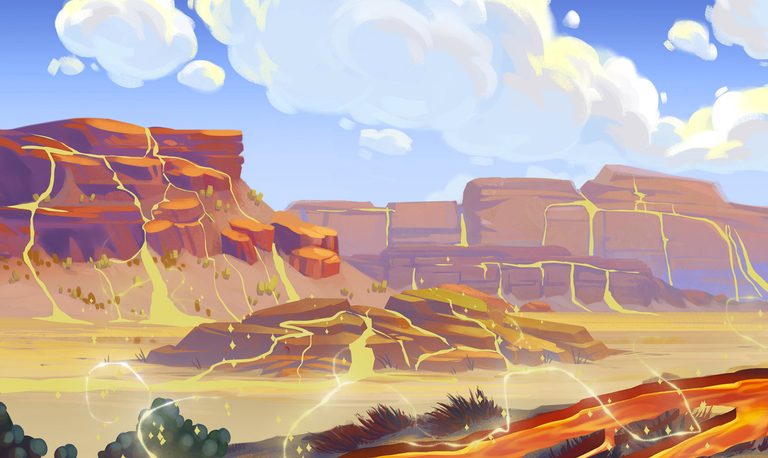
The Path Forward in Praetoria
The journey of land ownership in Splinterlands is only just beginning, with each phase unlocking new layers of strategy, economic opportunities, and interactive gameplay. As Praetoria develops, land mechanics will evolve to include advanced buildings, resource refinement, item and spell crafting, and ultimately the integration of these resources into battle. Each update brings fresh opportunities to enhance land productivity, explore untapped resources, and strategically contribute to the Secret of Praetoria initiative.
Staying Updated and Engaged
Splinterlands is a constantly growing ecosystem with frequent updates, community events, and new features. Players can gain an advantage by keeping up with the latest announcements from the Splinterlands team on the official Splinterlands blog on Hive and Discord server. Staying informed allows landowners to adapt to new mechanics quickly, ensuring they’re ready to capitalize on economic shifts or changes in gameplay strategy.
Contributing to the Community and Ecosystem
Active engagement within the Splinterlands community is vital for fostering a vibrant and supportive ecosystem. Sharing knowledge, participating in discussions on the Hive blog, and joining community challenges not only enhances personal gameplay but also strengthens the network of players working toward shared goals. By contributing insights and strategies, players collectively unlock the secrets of Praetoria, creating a thriving environment for both new and veteran landowners.
The journey in Praetoria is a communal one, and as players work together to uncover its mysteries, they also shape the Splinterlands world, leaving a lasting impact on the game’s evolving landscape.

*Disclaimer: This post has been written with the help of ChatGPT.
Over and Out,

Referral

Thanks for sharing! - @libertycrypto27

nice comprehensive post @ghostlybg